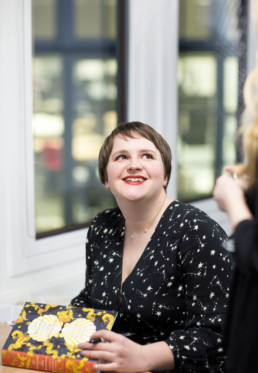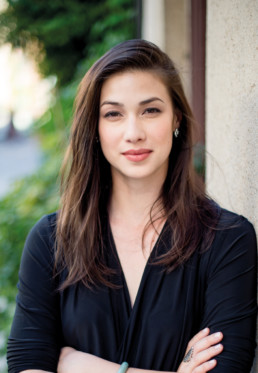City, University of London’s creative writing short courses have a reputation for helping budding writers to take the formative steps in penning their debut novels. But how does an aspiring novelist go from having a good idea to actually writing something as unwieldy and challenging as a debut novel? In the hope of some inspiration, Rebecca Ley met three alumnae making a big splash in publishing.
Feel like you’ve got a book in you? Well, join the queue. Sometimes it feels like it’s everyone’s long-harboured dream to have a novel published.
For many, it remains just that. But the graduates of City’s creative writing short courses are making it a reality. There are several City alumni with hotly anticipated novels either just published, or about to be so. But three in particular stand out.
Imogen Hermes Gowar’s The Mermaid and Mrs Hancock was released in February 2018 to glowing reviews. While Peng Shepherd’s “eerie, dark and compelling” The Book of M, was released in June 2018. And Harriet Tyce’s eagerly awaited debut thriller Blood Orange is set for release in early 2019.
All three are on track for the holy grail of creative writing: critical and commercial success.
Hermes Gowar was reportedly paid an advance of £215,000 after a ten-way bidding war. Shepherd was immediately snapped up after receiving an “offer so generous” she immediately accepted, while Tyce also got a six-figure bid from Wildfire.
And they are not alone. Other strongly tipped City alumnae include Deepa Anappara (shortlisted for the 2018 Deborah Rogers Writers’ Award for Djinn Patrol on the Purple Line) and Hannah Begbie (a former literary agent, who won the 2018 Romantic Novelists’ Association’s Joan Hessayon Award for New Writers for her novel, Mother). It’s enough to beg the question: what are they putting in the water on the creative writing courses at City?

Emily Pedder, Writing Coordinator for creative writing short courses at City, as well as Course Director for The Novel Studio postgraduate course, tutored Shepherd and Tyce, while Hermes Gowar and Shepherd both studied under Katy Darby, Visiting Lecturer in Creative Writing. Pedder, who also runs her own editorial consultancy (TheBookEdit.co.uk), says: “I know how transformative it is to be taught well and have someone engage with you at an early stage in your writing career and make it feel possible. We have got a terrific group of tutors.”
For all three writers, establishing the genre they were working in was key. “It’s like finding the right pair of gloves,” says Pedder. “We’re also not snobbish about genre writing at City; we just want good stories to be told.”
Certainly, all three novelists credit their time at City as pivotal, both in terms of taking themselves seriously as writers, but also in the sense of learning the essentials of their craft.
At this point, I should perhaps offer a quick disclaimer. It’s possible I find the trio’s trajectories particularly riveting because I’m also a City alumna (PGDip Periodical Journalism, 2003) who aspires to be a published novelist. So such stories of literary success are simultaneously inspiring and a tiny bit galling, if I’m completely honest.
But while the path to having their names running down the spines of books may seem frustratingly smooth, the truth is somewhat more complex. Behind every hyped City alumna with a whopping book deal and effusive reviews, there lies a story of research, redrafts and hours of solitary toil.
So what could they teach me, or any of us who daydream of literary success, about how to write a standout novel?

Imogen Hermes Gowar
Imogen Hermes Gowar’s novel, The Mermaid and Mrs Hancock, is a confection. As delicate and painstakingly whipped-up as one of the syllabubs that her character, the courtesan Angelica Neal, enjoys.
Set in the 1780s and progressively more steeped in its titular magical realism as it progresses, it’s one of those books that everyone seems to be talking about.
On the process of writing it, she says: “I was working in a café for the minimum wage and had nothing to lose. So I was pigheaded about it. I hated the idea of spending the rest of my life thinking I could have done it. The fear was of letting myself down.”
Hermes Gowar, 30, is the real deal; as bright and self-assured as you might expect from someone who has pulled off such a literary coup.
She was a keen writer from childhood, she says: “But my parents impressed upon me that it wasn’t a real job and I always loved history and museums, so that’s what I planned to do.”
She was working as an assistant at the British Museum when she started making up stories about the objects she saw and first had an idea about a mermaid, after seeing the fake one in the museum’s collection, made from the top half of a monkey stitched onto a fish’s tail.
After experimenting with an evening writing class at another London university, which didn’t feel right, she alighted on one at City.
Immediately, things started to slot into place. “I knew that I was doing well in the class,” she says. “I felt like I was flourishing. It was fantastic.”
Her progress led her towards an MA in Creative Writing at the University of East Anglia (UEA) where she found her experience from City invaluable, particularly the workshop-style format.
During a historical writing module at UEA, she started to experiment with the idea that would eventually become The Mermaid and Mrs Hancock. But instead of writing it immediately upon graduating, she chose to spend ten months researching the period in the British Library’s rare texts.
She says: “It was daunting to feel that I hadn’t started writing, but I just felt that if I wasn’t fully immersed in the [mid-Georgian] period, how could I write the novel? I wanted to know things like how long it took to get dressed and how you moved around your home.”
Hermes Gowar’s careful research extended to the physical. She walked around London to understand its geography as her characters would have done. “I also made and wore a robe de la reine, which is a flimsy muslin dress some women of the era wore. I was surprised at how freeing and radical it felt to wear something so unstructured,” she says.
She also cooked using a cookbook from the period, Frederick Nutt’s The Complete Confectioner. “We forget how rare things like ice and sugar were. We don’t think about the luxury of achieving these things nowadays,” she says.
Only after all of this did Hermes Gowar begin writing her novel and the depth of research is evident everywhere in the flawlessly rendered late-18th century milieu.
She worked in the café in the mornings, before writing in the afternoons after making a deliberate decision not to distract herself with a professional career.
She says: “I’d wanted to write a novel for so long, that I didn’t want to blow it. My boyfriend recently told me that he was really worried about me because I was so single-minded.”
Once she finally started writing, she set herself a target of a thousand words a day. “I usually managed it, but I’m never doing that again. There were days when I had to chain myself to the computer to achieve it and sometimes I ended up churning out stuff I had to lose,” she says.
After entering her novel into the Mslexia Novel Competition [Mslexia is an organisation committed to helping women writers progress and succeed] and becoming a finalist, she sent her manuscript out to seven agents. She attracted widespread interest but showed characteristic astuteness in taking her time to work out who to sign with. “You’re so grateful as a writer when somebody wants to represent you but the right agent is so important. I’ve seen people have a bad time with the wrong ones and it’s so dispiriting. I talked to the ones I met with about where they would position the novel and what edits they would want done,” she says.
She plumped for Karolina Sutton from literary agent Curtis Brown, who had first got in touch when she was at UEA and who negotiated her dazzling deal with Vintage; the very imprint that she had always hoped for.
With the book now released and enjoying superb reviews, further good news has swiftly followed. The film and television rights to The Mermaid and Mrs Hancock have been secured by BAFTA and Golden Globe-winning producer Colin Callender’s company, Playground.
And Hermes Gowar is now at work on a second book. She says: “It will be very different from my mermaid book. I’ve written one book, but I’m back at the beginning with this one.”
Nonetheless, I think it’s safe to expect good things.
Peng Shepherd
Peng Shepherd’s debut, The Book of M, is about a mysterious plague that causes people’s shadows to disappear. Strange as the idea may sound, it’s not entirely fictional.
Shepherd says: “I knew that I wanted to write something about shadows. They are used across cultures as symbols and myths, but I just had the image and not really a story, so I started Googling things and stumbled across Zero Shadow Day.”
This turns out to be an astronomical phenomenon which occurs when the earth’s rotation causes a certain area of land to become perfectly aligned with the sun, so that the sun is exactly over that place for a few minutes. In such a location, for the few minutes that the sun is overhead, people lose their shadows.
It happens in a region of India, where a portion of Shepherd’s novel is set and there the real Zero Shadow Day is apparently a kind of mini-holiday, complete with activities, social media hashtags and gatherings.
Yet in Shepherd’s hands, this becomes a terrifying epidemic dubbed the Forgetting, which robs large swathes of the world’s population of their shadows – and their memories.
It was in 2010 that Shepherd, 32, who grew up in Phoenix, Arizona, but had ended up working for a risk consultancy firm in London, resolved to take her writing seriously. “I saw that City had these six-week short courses,” she says, “so I thought I’d take one and see if it worked for me. I ended up taking four or five; they were so helpful. They gave me a community of writers and readers to share my work with and learn from, but what was also really impactful was how accepting my tutors were of my genre-tinged work.”
She adds: “Writing programmes have since become more genre-friendly, but back then literary fiction was definitely the main focus and I think a lot of writers felt pressured to write that way to be seen as talented, even if it wasn’t their true style. I was really nervous and sometimes embarrassed to submit my pieces that were so fantastical or science-fiction-esque, but my instructors Emily Pedder and Katy Darby were so encouraging, which really gave me the confidence to keep writing the way I wanted to write.
“I think that experience was invaluable. I don’t know if I would have kept going if I had felt like what I wanted to write wasn’t accepted. They were so important to me,” she says.
Pedder herself says that Shepherd’s star quality was easy to spot: “If I were betting on one of my alumni doing well, in my honest opinion, it would be Peng. She has all the attributes you need to succeed in the tough world of publishing… I taught her many years ago and was impressed then not just with her writing but with her ambition and motivation.”
Her City experience convinced Shepherd that she wanted to do a creative writing postgraduate course and she ended up on a full scholarship to the New York University MFA Creative Writing course (“no mean feat” as Pedder says).
After that, she found an agent by researching and making a list of her favourites, before querying them all with a letter, synopsis and the first few chapters. “It was absolutely terrifying,” she says, “but I was lucky to get multiple offers.”
This level of interest was sustained when her novel was submitted. “My agent sent the manuscript out and we started hearing back from several imprints that they loved it… but my now-editor at Harper Voyager UK was extremely interested and moved very quickly. My agent and I were very happy with the match because both imprints really seem to understand and embrace novels that blend literary and genre elements, rather than making them more into one or the other.”
Like Hermes Gowar, Shepherd has a quiet confidence about her. But she admits that she “tried and quit” writing several novels before she finished The Book of M. “The lesson I learned is that sometimes when a story isn’t working, it might not be yours to write,” she says.
What turned out to be seminal, for her, was switching to the word-processing program Scrivener for her creative writing. It enables you to move around chunks of text more easily and see the structure of your book at a glance. She says: “I switched over when I started The Book of M and I truly think it’s a not insignificant part of the reason I finished the novel. Almost none of my writer friends use it actually, but I would be lost without it.”


Harriet Tyce
Harriet Tyce’s debut thriller Blood Orange follows main character Alison Wood, a criminal barrister, as she leads a murder case, while in her personal life an affair threatens to cause repercussions.
Firmly positioned in the domestic-noir genre, its psychological suspense and shocking twists have prompted the now-familiar comparisons to books such as Gone Girl.
But Tyce, 45, who studied law at City and practised as a criminal barrister for a decade, before returning to City to take the Novel Studio short course, is perhaps better equipped than most to explore the nuance of the genre.
Unlike her character Alison, she “never got as far as having a murder” but her experience of the complexities of the criminal justice system informs the book.
This is an intelligent, considered, feminist domestic noir. Tyce says: “Violence against women isn’t going anywhere but what you can do is to ignore the lingering shots on the naked body. I really tried to make sure that Alison has agency.”
As a mother-of-two, Tyce says that she was drawn early on in her writing to the “ambiguities of motherhood. The themes of motherhood and guilt.”
As a working barrister herself, she found it hard to reconcile her career with having children. “After I had my first child I did try working part-time but the nature of the bar is that you get these last-minute calls. You might need to spend months living in a Travelodge in Nottingham,” she says.
So, after shelving her law career, the success of Blood Orange is a thrill. “I’d been out of things professionally for a long time before. It was an absolute godsend because I am ultimately an ambitious person.” She adds: “I still can’t believe it’s happening. It’s beyond my wildest dreams. I’m very happy and slightly shell-shocked. I sometimes feel like I’ve entered this alternate reality where everyone is just being really nice to me.”
City was crucial. “It was just a fantastic starting point in terms of structuring things and provided a systematic approach to the craft. The workshops where we had to share our work with the group were terrifying, but so instructive,” she says.
She went on to do an MA in Creative Writing Crime Fiction at UEA, a new and remote course. It was during this that she attracted agent interest.
She is refreshingly unpretentious about the process of writing: “Once I’ve done all the planning I can write quite fast. I try to aim for about 1,000 words a day, which I sometimes can do in an hour. I love a bit of distraction. I can do ten intense minutes and then spend some time on Twitter. I don’t necessarily believe you have to write every day, or any of those other rules some people have.”
Unlike Shepherd, she doesn’t use Scrivener: “It’s just too damn easy to move your chunks around.”
With rights to her book already sold in ten territories around the world, Tyce is on track for commercial success. She says: “It wasn’t a cynical decision to write in a commercial genre but that’s where I found my comfort zone.”
Unsurprisingly, she loves reading crime fiction herself, but also adored the Patrick Melrose novels and is a keen fan of television show, The Great British Bake Off.
Such a combination of dark and the cosily familiar sounds about right for the newest queen of domestic noir.
Ten tips: How to write a bestsellerthe City way
- Research, research, research. Take the method writing route. Eat, walk and even dress like someone from your book. Once Imogen Hermes Gowar had done this, she felt ready to inhabit her characters.
- Work out what genre you’re writing in. When it feels right and ‘fits like a glove’, you’re good to go. All three of the books by City alumnae are genre novels and stronger for it.
- Write for a set period each day rather than getting hung up on the word count. For The Mermaid and Mrs Hancock, Hermes Gowar set herself a target of 1,000 words a day, but for her new novel she has chosen to write for at least two hours a day instead.
- Distract yourself regularly with amusing Twitter threads, funny videos and gifs like Harriet Tyce. Concentration is important, but you don’t need to be a social media refusenik to write something good. And you’ll probably need a social media profile if you ever publish it.
- If the lure of Instagram really does get too strong, install Freedom, or another internet-blocking tool, as Tyce sometimes does to avoid distraction.
- Get started on your fiction before 10am like Peng Shepherd or the rest of the day will swallow you up.
- Go high concept. Hang your novel on one really memorable idea or motif, like Shepherd and Hermes Gowar.
- Use Scrivener. It allows you to analyse the structure of your book at a glance. For Shepherd it was key to her success.
- Don’t use Scrivener. For some the ability to easily move chunks of text around can get too confusing (as Harriet Tyce found).
- Don’t be too precious or get hung up on ‘rules’ for how to write a novel.

Need help with your novel idea? City offers a diverse range of fiction short courses from short stories to novel writing and has a strong track record of published alumni. For more information on the University’s flagship one-year Novel Studio course and all City’s other courses visit: www.city.ac.uk/study/courses/short-courses/writing

Contributor:
Rebecca Ley (PGDip Periodical Journalism, 2003) is a freelance features writer and editor. She writes regularly for the Daily Mail, wrote an acclaimed column for The Guardian and is an obituarist for The Times. She is also currently working on a novel.
Illustrations by Diego Pedauye.